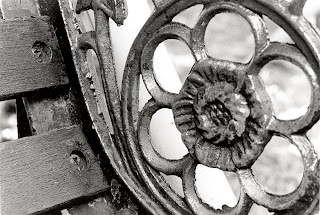
OBJECTIVES
This assignment has two primary objectives: finding the use of lines & shapes.
1. Learn to get the right amount of exposure in outdoor daylight settings.
2. Learn through experimentation to recognize the elements of art through lines & shapes.
LOADING THE CAMERA
Failure to properly load the camera results in totally blank transparent negatives with only frame numbers showing along the edge.
Follow these steps (unless you have a motor drive):
1. Check your film speed and set the camera's ASA.
2. Install the film being sure to attach it to the take-up spool and repeatedly operate the advancing lever (squeezing shutter button as needed) until both top and bottom sprockets are engaged in the film sprocket holes.
3. Close the camera back.
4. IMPORTANT. Turn the crank as the arrow indicates until the film is snug, but do not force it.
5. While watching the crank, advance the film 2 times (squeezing shutter button as needed). If the crank turns, the film is properly moving. If the crank does not turn, open the camera and reattach the film leader and try again. Repeat steps 4 and 5 until it works correctly.
6. After each picture, observe the rewind crank as you advance the film. If turns while you advance the film all is well.
7. At the end of the film, don't force it. The film can break off if forced.
8. If you can keep advancing it forever, cry now. The film was never connected in first place or it broke. Don't rewind or open the camera, in a changing bag to see if the film can be salvaged (feel free to ask for help). Do not touch the fragile shutter or mirror in your camera.
WHAT TO DO
Become an observer. Look for lines and shapes in everyday objects, places, & things. Lines can show direction and movement. Everything is compose of shapes. Make sure that your EMPHASIS shows lines and/or shapes. Don’t forget about your aperture & depth of field. Set your aperture according to the depth of field you would like. Remember the lower the number (f/3.5 or f/4) the less depth of field you have. The higher your number (f/16 or f/22) the more depth of field you have. After you have set your aperture, meter, and set your shutter speed according to your light meter. DON’T FORGET: SHUTTER SPEED SHOULD NOT BE LESS THAN 60TH OF A SECOND. DO NOT SHOOT INDOORS, AT NIGHT OR IN LOW LIGHT SITUATIONS. YOU WILL HAVE A DIFFICULT TIME GETTING THE RIGHT EXPOSURE. DO NOT SHOT IN SCHOOL.
THINGS TO DO AS YOU ARE TAKING THE PICTURES
Look at your notes for creating a good composition. Keep this tips in mind.
· Vertical/horizontal
· Different point of view
· Rule of thirds
· Content/subject
· Get close
· Fill the frame
· Avoid distracting backgrounds
· Leading lines
· Shapes
· Contrast
· Emphasis
· Balance
· Sharpness
PROCESS FILM AND CONTACT PRINT THE NEGS
See appropriate instructions and in-class demonstrations. After processing examine the negatives for exposure and contrast range. Note any irregularities and be sure to find out the reason for them. Create a contact sheet with your negatives. It is easier to make compositional choices from positive than from negatives. It is better to make exposure choices from the negatives themselves. Circle or mark at least 5 photos that you feel are your best. Make sure they are marked before turning them to be graded.
PRINTING
Save every test strip and ruined piece of paper used while printing this assignment. We will discuss this during critique. We can often think of ways to cut waste and your cost. A certain amount of waste will always happen. It is not counted against you in the grade, but you pay for the paper.
Save every test strip and ruined piece of paper used while printing this assignment. We will discuss this during critique. We can often think of ways to cut waste and your cost. A certain amount of waste will always happen. It is not counted against you in the grade, but you pay for the paper.
____ 1. Print 5 prints (5x7 inches).
____ 2. Print at least two 8x10's from the negative you like best. Be sure to print a full range of contrast in this print with some white-white and some black-black. Include all possible textural information in all the tonal areas including the light and dark parts of the print. This is the final print for this assignment. This will be printed after critique.
FEEDBACK
During critique you will be able to discuss the results with the instructor and students in class. Bring all prints, wasted paper, negatives, contacts, shooting record and printing records.
No comments:
Post a Comment